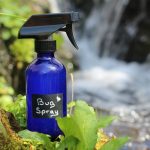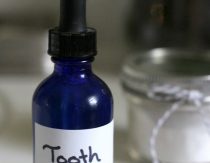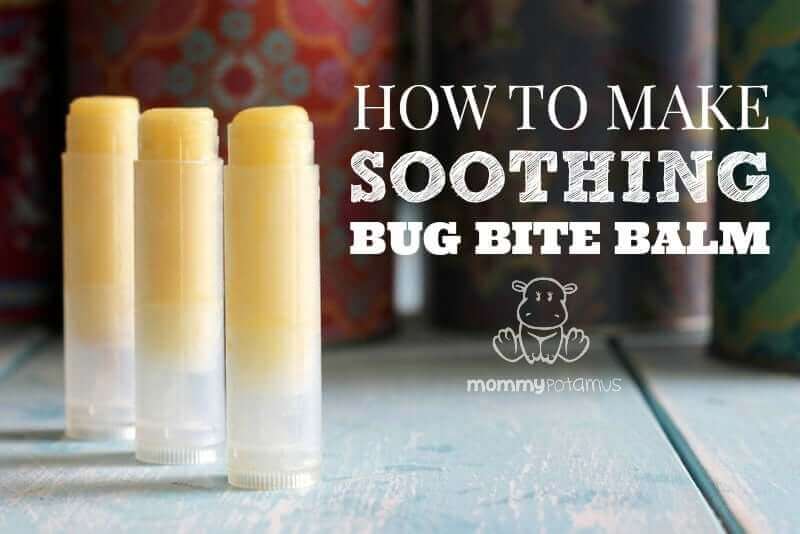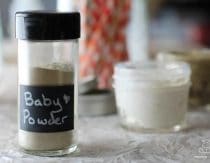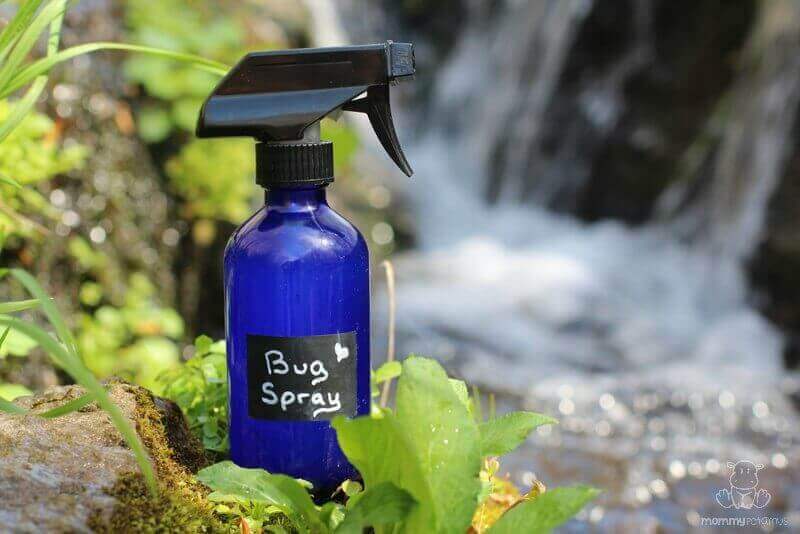
Jack Frost skipped us this winter, and you can guess what that means. Yep, instead of dying off in a deep freeze, the bugs from last season are out in full force.
That’s why I’m making up a batch of this easy homemade bug spray, which has worked really well for my family over the years. We use it any time we head to a neighborhood BBQ, summer concert, hiking trail, or even just our own backyard.
In this article I’ll cover which oils can be used – you probably already have a few of them on hand – plus safety information and what to buy if you don’t want to DIY.
So, which essential oils repel ticks, mosquitos, gnats and other bugs?
There are a lot of essential oils that have insect repelling properties, and many of them have additional therapeutic benefits as well. Here are my top nine based on personal experience and available research.
Also, if you’d rather invest in just one bottle instead of several different essential oils, you can use a pre-made blend such as the Shield Me (safe for everyone including kids) or Nature Shield.
1. Catnip Essential Oil
Catnip (Nepeta cataria) has long been brewed as an herbal tea to support digestion, relaxation and restful sleep. However it’s impact on other animals is different. When cats eat it they tend to become relaxed as well, but when they smell it it usually has the opposite effect.
So what kind of effect does it have on bugs? According to Science Daily:
Researchers report that nepetalactone, the essential oil in catnip that gives the plant its characteristic odor, is about ten times more effective at repelling mosquitoes than DEET — the compound used in most commercial insect repellents.”
Unfortunately it smells kinda, well, not great, so don’t plan on using this one alone.
Other uses for catnip: Along with diatomaceous earth and a few other ingredients, it makes a great natural flea and tick powder for dogs.
2. Cedarwood Essential Oil
Chests made from cedarwood have been used for generations to store clothing while repelling insects such as moths.
Calming, skin soothing and absolutely delightful in this Wild Vanilla No. 2 Solid Perfume Recipe, cedarwood (Cedrus atlantica) is also often used to repel mosquitos.
Other uses for cedarwood: It’s a lovely addition to both homemade arnica cream and homemade body wash.
3. Citronella Essential Oil
If you search on the EPA’s guide to insect repellents, you’ll find that when you specifically search for repellents for ticks it lists three oils as active ingredients that can be selected.
Citronella (Cymbopogon winterianus) is one, and catnip (listed above) and lemon eucalyptus (listed below) are the others.
Other uses for citronella: Outdoor citronella candles
4. Geranium Essential Oil
In this study, geranium(Pelargonium graveolens) was found to repel lone star tick nymphs.
Other uses for geranium: It supports skin repair and renewal, elasticity and firmness, and even skin tone, which is why I use it in my hydrating skin serum recipe.
5. Lavender Essential Oil
Lavender (Lavandula augustifolia)- Calming, helpful for soothing bug bites, sunburns, and other skin irritations. In a study on hairless mice, lavender was effective at repelling adult mosquitos. Although I don’t typically use it in my DIY bug spray, if you already have it at home it can be used as a substitute for tea tree or patchouli essential oil.
Other uses for lavender: I always keep a large bottle on hand for making all-purpose cleaner with lemon and lavender, diaper rash cream, homemade air freshener, magnesium body butter, and tallow skin balm.
6. Lemon Eucalyptus Essential Oil
According to the American College of Healthcare Sciences:
“In a 2010 study,[7] three species of eucalyptus (E. staigeriana, E. citriodora, and E. globulus) were tested for use with the blood-sucking sandfly, lutzomyia Lutzomyia longipalpis. Researchers found the eucalyptus essential oils were more effective against L. longipalpis than other natural products.” (source)
The E. citriodora variety can be found here.
Other uses for lemon eucalyptus: Makes a great addition to homemade granite cleaner.
7. Patchouli Essential Oil
According to this study, constituents found in patchouli essential oil(Pogostemon cablin) repelled several different types of mosquitos.
Other uses for patchouli: It makes a great addition to men’s personal care products, like this homemade deodorant.
8. Tea Tree Essential Oil
In one study, researchers looked at whether tea tree (Melaleuca alternifolia) is a viable alternative to synthetic repellents for mosquito protection. They found that it did have mosquito-repelling properties, but did not last as long as the synthetic stuff. They concluded that tea tree may have “potential as a short-period repellent or under conditions of low mosquito abundance.”
Other uses for tea tree: I love it in this face wash recipe.
9. Vetiver Essential Oil
According to the American College of Healthcare Sciences:
In Java, Indonesia, sustainable vetiver essential oil production has produced a viable vetiver craft industry with items such as aromatic mats, baskets, candles, and soaps—all being produced from the spent root. The added benefit is vetiver acts as a natural mosquito deterrent in the house. Diffusing a few drops of this oil will help repel the mosquitoes and also create a spicy, Balinese ambience for summer.”
You can find vetiver (Vetiver zizanoides) here.
Other uses for vetiver: Relaxing and emotionally grounding, it’s wonderful in essential oil diffuser blends and this DIY beard oil.
What Else You’ll Need
In addition to essential oils, you’ll need a high proof vodka to help solubilize (disperse) the essential oils evenly throughout the liquid, plus either distilled water or fractionated coconut oil to dilute it.
Here are the pros and cons of each:
- Water – Dries very clean but reduces shelf life to only a few weeks. May be drying on skin if applied to often.
- Fractionated Coconut Oil – Longest lasting spray with just a tiny smidge of moisturizing properties that help counteract the drying effect of the alcohol. If sprayed in huge quantities it may leave a little oil residue on clothes.
DIY Homemade Bug Spray Recipe
Equipment
- 4 ounce glass spray bottle
Ingredients
- 6 tbsp Everclear or other high proof alcohol (151 or 190 proof)
- 2 tbsp fractionated coconut oil
- 60-70 drops essential oil (see notes section for suggested combinations)
Instructions
To Make
- Start by adding the Everclear and essential oils to your glass spray bottle (or bottle made with PET plastic). Put the nozzle on and give the bottle a shake, then allow the mixture to sit for one hour so that the essential oils can fully solubilize (disperse).
- Next, add the distilled water or fractionated coconut oil and shake to combine.
To Use
- Shake well, then spray onto your body/clothing. Don't spray directly on the face and neck – instead, spray some liquid into your palm and apply with your fingertips. Reapply as often as needed. If you're using the formula with fractionated coconut oil, be aware that it may stain clothing.
Special Notes for Kids Under Two
- Even when using child-friendly oils, I recommend avoiding topical application for children under two. Instead, when my babies were over six months old but under two, I sprayed their clothes rather than their skin. For babies under six months old, netting, fans and clothing should be used to keep bugs off baby's skin.
Notes
- 25 drops citronella essential oil (can substitute lemon eucalyptus if desired)
- 20 drops cedarwood atlantica essential oil
- 20 drops geranium essential oil
- Optional addition – 5 drops catnip essential oil
- 25 drops patchouli essential oil
- 20 drops cedarwood atlantica essential oil
- 20 drops geranium essential oil
- Optional addition – 5 drops tea tree or vetiver essential oil
What To Buy If You Don’t Want To Make Your Own
DEET-free Wondercide Bug Repellent is the best option I’ve found. I personally would opt for the cedar formula (or lemongrass for kids over two) instead of the ones with peppermint or rosemary oil. Although many kids won’t have a reaction to peppermint or eucalyptus, for some it can cause breathing issues so I don’t use it with kids under six.
You can read more about special considerations with peppermint/rosemary oil and children here.
Frequently Asked Questions
Below are answers to the most common questions I’ve received since first posting about DIY bug spray years ago.
Are these recipes safe for kids?
YES. Although there are other essential oils that are helpful for repelling insects, I decided to keep things simple and only include options that are considered safe for the whole family.
Special Note Regarding Kids Under Two: Even when using child-friendly oils, I recommend avoiding topical application for children under two. Instead, when my babies were over six months old but under two, I sprayed their clothes rather than their skin. For babies under six months old, netting, fans and clothing should be used to keep bugs off baby’s skin.
What about pregnant and nursing moms?
Yes, these recipes are safe to use during pregnancy and nursing. However, many experts urge women to be cautious about application during the first trimester. If it were me, I’d probably opt to just spray my clothes during that period.
Special note on dilution ratios: For general use, a topical dilution of 1% is usually recommended during pregnancy – the typical dilution suggested for adults is 2.5%. However, there are instances when a higher dilution ratio is considered appropriate, such as to repel bugs.
The recipes above are just under 3%. If I were pregnant/nursing and using these everyday I would probably either dilute them more or just spray them on my clothes. However, if I was just using them occasionally I would go with the recipe as it is.
Can I use witch hazel, apple cider vinegar or regular vodka instead of Everclear?
While you’ll find a lot of DIY recipes that use these ingredients, experts in the fields of essential oil formulation have recently published information which states that they are not effective at evenly dispersing essential oils and should not be used. For more information, check out this article: Effective Use of Alcohol for Aromatic Blending.
Does This Spray Kill Ants?
While it might, if you’re trying to get rid of ants in the kitchen or just outside the house, check out this article on how to get rid of ants naturally.
Any tip for soothing bug bites I already have?
This bug bite balm soothes mosquito bites, ant bites, and more.
Do you have recipe for ticks specifically?
Yes, you can check out my tick spray recipe here.
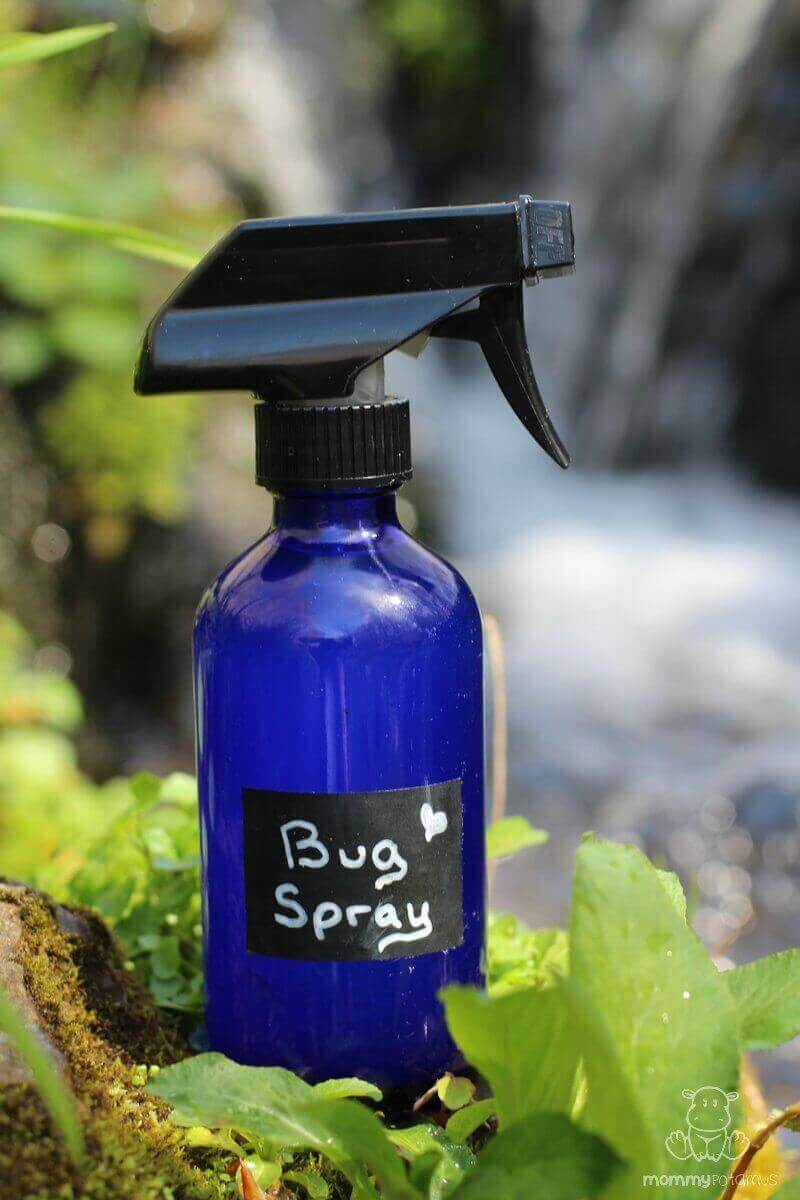
Want a FREE ebook of non-toxic cleaning recipes that WORK?
I’ve created a free ebook for you as a gift for signing up for my newsletter. 7 Non-Toxic Cleaning Recipes That Really Work covers seven recipes that you can make in just a few minutes each for squeaky clean windows, sparkling dinnerware, lemon-fresh countertops, and more. Subscribe to my newsletter below and you’ll be redirected to a download page for immediate access to this PDF ebook.

